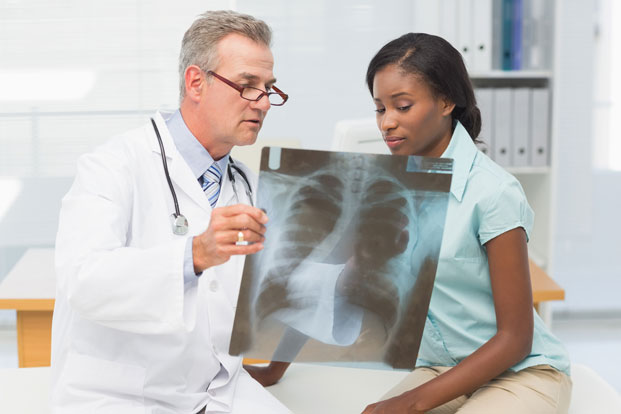Sarcoidosis is a disease that lacks awareness. Once thought rare, it’s now recognized as common and affects many people around the world. Its symptoms are mild, so it’s hard to diagnose, often only discovered when the patient has a chest X-ray or when the disease advances.
There are no real statistics about how many cases of sarcoidosis actually exist. It can affect anyone of any age, race or gender, but appears mostly among African Americans (for whom the chances of developing the disease may be as high as 2 percent) and those with Scandinavian ancestry. The appearance of sarcoidosis is slightly higher for women than men.
The symptoms outside the lungs can include chronic uveitis in African American eyes; skin lumps in Northern European Americans; and problems with the eyes and heart in Japanese Americans.
Some common signs include inflamed lumps in the lungs, causing coughing, wheezing, shortness of breath or chest pain. Patients also may experience extreme tiredness, depression or anxiety, as well as night sweats and weight loss. In some cases, sarcoidosis may enlarge the lymph nodes in the neck and chest, under the chin, in the armpits, and the groin. It can also cause lumps, ulcers or areas of discolored skin that itch. The skin patches can linger for a long time.
Sarcoidosis in Children
Children who may have the disease often exhibit a loss of appetite, joint and bone pain, and fatigue accompanied by weight loss. Children younger than age 4 may experience enlarged chest lymph nodes, eye swelling or redness, and skin lesions.
In extreme conditions, sarcoidosis can become a serious skin disease called lupus pernio. This is a potentially serious condition that may result in disfiguring sores to the nasal passages, cheeks, eyelids, fingers and nose. They are hard to get rid of and may return even after treatment.
The eyes are particularly sensitive to sarcoidosis and can experience burning, itching, pain and sensitivity to light.
Finally, sarcoidosis may attack vital organs. You may get an enlarged liver or experience salivary gland or spleen problems. In rare instances, the heart or brain can be attacked, resulting in shortness of breath, abnormal heartbeat, vision problems and headaches.
Some Good News
Extreme cases of sarcoidosis may lead to Lofgren’s Syndrome. This is a disease characterized by lymph nodes, fever, arthritis, and a rash on the ankles and shins that is warm to the touch.
The good news is that sarcoidosis can disappear as mysteriously as it first appeared. There’s no telling whether it will linger because there often is no indication in the patient, and those afflicted may recover without ever knowing they have the disease. Typically, the first signs of the disease include a persistent cough (in some patients, this makes speech almost impossible), wheezing, chest pain and shortness of breath.
The bad news is when the disease lingers. Long-term sarcoidosis means that a pulmonologist needs to prescribe treatment and long-term care. If left untreated, sarcoidosis can lead to irreversible damage to the tissue between lung air sacs, which makes breathing difficult; impaired eyesight to the point of blindness; kidney and other major organ failure; or interfering with the delicate electrical signals of the heart, resulting in abnormal rhythms and potentially death. The nervous system also can be affected, with the disease manifesting in facial nerves and causing paralysis to that region.
If you visit a doctor, write down your questions in advance and make a list of symptoms. If you know when they began, note that and provide a timeline of any changes. Make sure you know your medications and any supplements you choose. Your doctor will determine what further tests and treatments may be needed.
The office visit likely will start with a close examination of your entire body, including probing any skin lesions if you have them. If you have previously been X-rayed for the condition, the doctor will want to examine those charts to see any warning signs of sarcoidosis that may have been missed in prior examinations.
From there, treatments include further X-rays to determine the extent of lung damage or the presence of enlarged lymph nodes in the chest; a CT scan, if deeper examination of an afflicted region is suggested; a PET or MRI, if heart or nervous system problems are suspected; and a blood test, which will measure heart, kidneys and liver function. Your pulmonologist may refer you to an eye doctor in some cases.
In rare instances, the doctor may recommend a biopsy of the lung tissue or other areas. This seizure of a small sample of tissue will be looking for the small lumps called granulomas, which form as part of the early stages of sarcoidosis. The lung or lymph node biopsy will be obtained with what’s called a bronchoscopy, which uses a thin, flexible tube that is inserted down your throat. The tube contains a camera and can clip off an area of tissue.
No Cure: Sarcoidosis Treatment
There is no cure for sarcoidosis, but in severe cases, doctors will attempt to monitor it closely with regular X-rays and examinations. They may also recommend a round of medication treatments, including corticosteroids, powerful anti-inflammatory drugs that can be applied directly to the skin or absorbed through an inhaler; using anti-rejection medications, which reduce inflammation by suppressing the immune system; and anti-malarial drugs, which may calm conditions of the nervous system and skin areas while treating elevated blood calcium. Doctors also may use tumor necrosis factor-alpha (known as TNF-alpha) treatments, which are usually used in rheumatoid arthritis treatments but can be used for other cases. This is typically only used for sarcoidosis when nothing else seems to be working.
Finally, in the worst-case scenario, you may be a candidate for a transplant of the lungs or other organs if sarcoidosis has caused severe damage.
Most cases go away with little to no treatment. Speak to your doctor if you believe your persistent cough may be a sign of something beyond minor irritation.

Leave a Reply